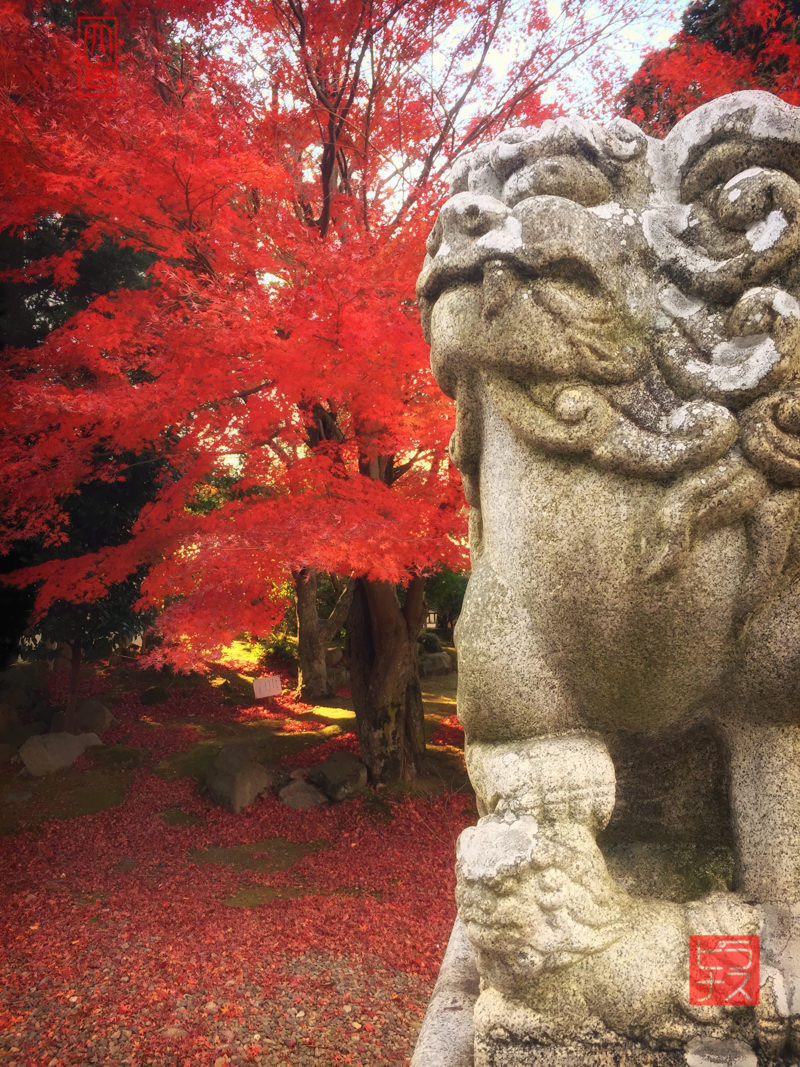Autumns can be magical in Japan, especially in places thick with Japanese maples, which turn a deep blazing red. Shrines, too, carry an otherworldly air with their quiet grounds and guardian statues. Combine the two and you get something really special, as I did in the following haiku:
狛犬よ友よともにや紅葉見る
komainu yo tomoyo tomo ni ya momiji chiru
komainu, old friend
let us watch the red leaves fall
autumn at the shrine
— Tenjōka[1]

I enjoy spending time at the shrines of Japan. The smaller ones are usually quiet and peaceful. They might be located in busy areas, between buildings or next to busy roads, but they are crammed full of nature which often does a good job of absorbing much of the outside noise, leaving a sanctuary of sorts.
This photo is from a past autumn. On this particular visit, I was inspired to compose the haiku at the top of this post.
Some misc info about the stone statue you see. I have a post about this somewhere in my archives that I will restore one of these days, but until then…
Komainu (狛犬)[2] is a kind of lion-dog that protects against evil. The word itself means Korean Dog. Presumably when they came over by way of Korea with Buddhism, the Japanese thought they looked like dogs so named them accordingly.[3] In China they are suppose to be lions, hence the typical English translation lion-dog.[4] The lion is often associated with the teachings of the Buddha, where it is said that the teachings of the Buddha hit people like the roar of a lion.
There are always two komainu together, often flanking the entrance or path to a shrine: one with mouth open (阿, a), and one with mouth closed (吽, un). Together they represent the beginning and the end of all things or अ–हुँ (a-hūṃ) in Sanskrit, an idea also represented by the seed syllable that will be familar to many of you: ॐ (om).[5]
But—I hear you cry—why are Buddhist lion-dog guardian statues in a Shinto Shrine if they are, y’know, Buddhist? Ah, now there’s a question! One that will have to wait for next time, Grasshopper.[6]
So here we have a Buddhist lion-dog statue from Korea — originally from India, moving East by way of China — guarding a Shinto shrine and enjoying the leaves. Then there’s me, the strange foreigner who likes to talk to statues. Hmm.
-
That’s me! I’m playing with using it as a penname. See here. ↩
-
pronounced koh-my-new ↩
-
“Koma” likely referred to Korea as a whole, but some scholars suggest it may have specifically meant Goguryeo — one of the three Korean kingdoms at the time, and the one most closely allied with Japan. ↩
-
In English these statues are often (mistakenly) called “fu dogs.” The mix-up comes from a mistranslation long ago, probably confusing 獅 (shī, “lion”) with 福 (fú, “good fortune”). In China they’re properly called guardian lions (shī), which in Japan became shishi (獅子). Komainu is the more common Japanese term. ↩
-
अ–हुँ was transliterated in Japanese as 阿吽 (a–un). As you can see above, that word was then broken up to give each komainu their name. Often 形 (gyō, shape) will be attached, making their names 阿形 (agyō) and 吽形 (ungyō). ↩
-
preview: for much of Japanese history, Shinto was a part of Buddhism. If you are a history/mythology nerd like me and want the technical word for this, it’s Shinbutsu-shūgō (神仏習合). ↩